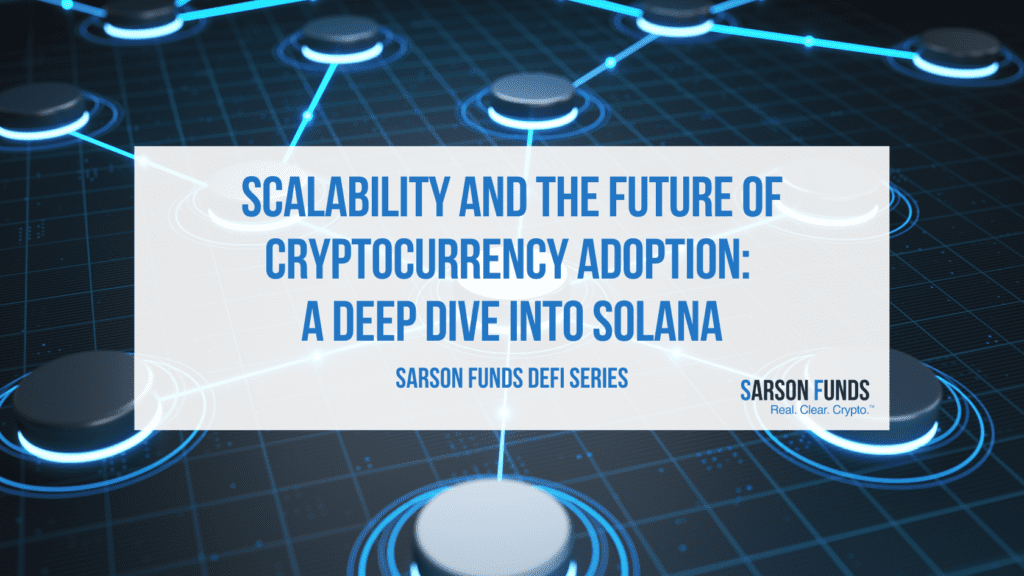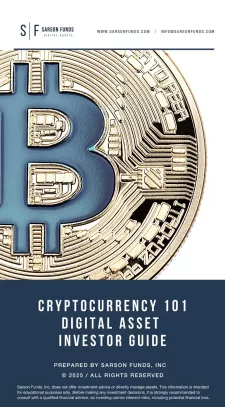
In our next segment of Sarson Funds’ Defi Series, we will focus on a cryptocurrency and blockchain network called Solana. Solana was founded in the fall of 2017 by respected computer programmer Anatoly Yakovenko. With Solana, Yakovenko aspired to revolutionize the capabilities of blockchain technology and present a new iteration that contained features unlike any other. This article will highlight the differentiating features of the Solana blockchain, including its decentralized clock, proof of stake consensus mechanism, smart contracts, transaction speeds, NFTs, and energy use, as well as some weaknesses of the network. Our hope in presenting this information is to help you understand why it is important for different iterations of blockchain technology to innovate and push the bounds of possibility.
Solana’s Decentralized Clock
While pondering weaknesses of popular coins like Bitcoin and Ethereum, Yakovenko landed upon the idea of time stamping transactions through a decentralized clock. Prior to Solana’s inception, blockchains lacked the ability to properly timestamp every transaction grouped in a block, posing security risks for the order of the transactions. The purpose for a decentralized clock is to enforce accuracy in the blockchain.
A problem commonly seen in the Bitcoin blockchain occurs when miners unlock blocks of the blockchain at the same time as another miner. This is problematic because only one miner’s block will be added to the chain, while the other’s will be discarded. The blockchain temporarily splits when this occurs, and the miner with the longer chain will end up being added to the blockchain while the shorter is discarded. This procedure is problematic because it neglects certain transactions that occurred on the network, which is where the demand for a decentralized clock comes into play.
By time stamping each transaction, Solana’s decentralized clock removes the ordering problem experienced in competing blockchains. This cryptographic timestamp of each transaction makes it possible for the chain to effectively order each transaction based on time of occurrence. This clock also prohibits a validator to organize transactions to their advantage, which strengthens Solana’s aim to be censorship-free network while maintaining high levels of security and synchronization. This creation is also coupled with Solana’s proof-of-stake consensus, making the chain incredibly energy efficient and even more secure.
Proof-of-Stake Network Consensus
Solana uses a proof-of-stake consensus which differentiates itself from other coins like Ethereum and Bitcoin. In both Ethereum and Bitcoin, a proof-of-work consensus is the social norm amongst the blockchain validator nodes. Proof-of-work is carried out by rewarding those who mine proof-of-work cryptocurrencies, giving more rewards to people who have a higher hash rate for mining speed. Basically, it rewards miners who have higher computational power than other miners. The unfair competition that proof-of-work enables is problematic because it allows for groups of miners to unite and make mining pools that divide the rewards, highly inflate energy usage, and in return, make the network more centralized. This is where Solana’s proof of stake consensus can provide value. Instead of miners, Solana uses network validators. Validators are in charge of approving transactions and adding new blocks to the chain. These validators delegate their coins as a stake in the network, while the network “randomly” chooses which validators will validate the next block. Validators are chosen through the size of their share of the stake, meaning that the higher the stake increases their chance of getting chosen. The validators profit off of the transaction fees of each transaction they approve. The reason why this consensus is more secure compared to others is because it eliminates the barrier of entry that the reliance on exceptional technology brings. The blockchain randomly chooses validators, making the network more decentralized, and disincentivizes the approval of fraudulent transactions through the threat of slashing a misbehaving validator’s stake. These features support the industry-wide shift toward proof-of-stake consensus as a more secure, energy efficient, and decentralized approach to blockchain technology.
Smart Contracts
Another aspect of Solana that separates it from many other blockchains is its ability to host smart contracts. As seen in our previous Ethereum article, smarts contracts are simply a game changer when understanding the potential of blockchain technology. These smart contracts allow for possibilities far beyond basic transactional efficiencies. They allow for the existence of dapps that enable a whole realm of decentralized possibilities. For example, dapps make decentralized play-to-earn gaming possible, while creating secure and decentralized platforms for various other types of applications. NFTs are also being bought, sold, and created on Solana’s blockchain through smart contracts, making this coin very competitive next to its rival Ethereum. NFTs are known for being embedded in the Ethereum blockchain, but Solana may be the new hub for these tokens to exist. Why may this shift underway? Transaction speeds and gas prices.
Transaction Speeds
A strong distinction for Solana’s network is its superior transaction speeds. This coin’s efficient programming allows it to be the fastest blockchain in existence. Solana’s transaction speed is between 50,000 to 65,000 transactions per second (TPS), while Ethereum approves transactions at a mere 15 TPS. Theoretically, Solana has the architecture to compensate for a limit of 710,000 transactions per second, leading us to believe that this current transaction speed is only the start for what Solana may soon be able to withstand. The speed of this coin is truly state of the art and is why the chain is a major competitor to leading smart contract layer 1 blockchains like Ethereum. Solana’s speed matched with its comparatively cheap gas fees also make this network valuable for NFT deployment and interaction.
NFT Capabilities
Solana’s blockchain supports an expansive NFT ecosystem due to its low entry barriers. Solana’s average fee is $0.00025 per transaction, while Ethereum’s average transaction fee is $52, making Solana more desirable in the eyes of the average consumer with its substantially lower total prices for transactions. As the NFT ecosystem rises in demand, Solana could very well be the future leader of this market because of its exceptional speed and low cost.
Energy Use
The best part about Solana some would argue would not be its cost or speed, but rather its energy efficiency. The elephant in the room when talking about crypto is sustainability. Bitcoin and Ethereum alone use enough energy each that some countries do worldwide. To put this into proportion, Bitcoin uses 6,995,592,000 Joules of energy for one transaction, Ethereum uses 692,820,000 Joules per one transaction, while Solana only uses 1,837 Joules – a sizeable and baffling difference. The implementation of cryptocurrencies and blockchain technology worldwide is argued against by many solely due to the energy usage of leading networks. If Solana can sustain efficiency at a fraction of the energy used by leading coins, then this token may be a potential solution for the blockchain scalability problem.
Downsides
Although Solana has an immense number of positive attributes, there are downsides as well. One particular downside is that due to its fairly small size in comparison to Bitcoin and Ethereum, Solana’s decentralization is threatened. Solana is decentralized but only has 1,000 validators in its blockchain compared to the roughly 200,000 Ethereum has. The more validators in a network, the more decentralized a network is, so with only having 1,000 validators, Solana stands as a less decentralized network compared to others. With cryptocurrencies and blockchain technology aiming to exterminate centralized power, this datapoint is troublesome for Solana. Solana’s blockchain has gone offline multiple times in its existence and leads many to doubt the network’s long-term viability.
Another potential negative attribute of Solana is its lack of supply cap. Cryptocurrencies aim to solve the problems of inflation, but with no existent supply cap, inflation does exist in the Solana network. Solana’s creators have historically increased the supply by 8% each year but have now decided to decrease their rate of supply growth to only 1.5% yearly. With this continual increase of supply, inflation can occur and will continue to occur. Supply adjustment is good for macroeconomic policy actions, so knowing that this can happen with Solana makes it a viable infrastructure for future nation state digital currencies and strengthens the narrative of Bitcoin as a store of value asset because of its 21 million BTC supply limit.
While there are certain negative attributes to every blockchain and cryptocurrency ecosystem, it is important to recognize Solana’s position as a truly cutting edge, influential, and efficient cryptocurrency network. Solana introduced time stamping in order to create increasingly seamless financial transactions on the blockchain through its revolutionary decentralized clock. Solana’s proof of stake consensus also works to keep its blockchain as secure as possible, lessening the threat of malicious validator collusion that is frequently seen in many blockchain networks. Solana even made possible transaction speeds that were only once dreamt of, leaving other blockchains figuratively in the dust. Not only has Solana changed the frontier of possibility for future ecosystems, but it executes these determinants in an energy efficient manner. Solana has truly established itself as a prominent industry first mover and is one to watch in the future of crypto. Stay tuned for our next chapters of the Sarson Funds DeFi Series where we will introduce more blockchain networks that push the bounds of innovation and are reimagining the future of global systems.
By Colm McDonald
Disclosures: Not investment advice. It should be assumed that Sarson Funds or its affiliated managers hold positions in all projects that are discussed. It is not possible to invest in any project directly through Sarson Funds, Inc. or its affiliated managers. Any investment product offered by managers affiliated with Sarson Funds should be assumed to be only available to Accredited Investors and subject to the individual terms and conditions of that offering including but not limited to those eligibility requirements associated with U.S. Securities Regulation D, section 506c. Talk with your financial advisor before making any investment decisions or have them contact Sarson Funds directly at [email protected]








